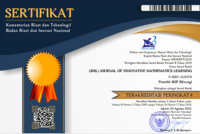


(JIML) JOURNAL OF INNOVATIVE MATHEMATICS LEARNING published by IKIP Siliwangi, Indonesia an international journal, provides a forum for publishing the original research articles, review articles from contributors, and the novel technology news related to mathematics education that is published four times a year: March, June, September and December. Scientific articles dealing with design research, development research, etc. are particularly welcome. The journal encompasses research articles, original research reports, reviews, short communications, and scientific commentaries in mathematics education.
All papers submitted to the journal should be written in good English. Authors for whom English is not their native language are encouraged to have their papers checked before submission for grammar and clarity. English language and copyediting services can be provided by International Science Editing and Asia Science Editing. The work should not have been published or submitted for publication elsewhere. The official language of the manuscript to be published in (JIML) JOURNAL OF INNOVATIVE MATHEMATICS LEARNING is English.
1. General Author Guidelines
All manuscripts must be submitted to (JIML) JOURNAL OF INNOVATIVE MATHEMATICS LEARNING Editorial Office by Online Submission at the E-Journal portal address: https://journal.ikipsiliwangi.ac.id/index.php/jiml, where author register as Author and/or offered as Reviewer by online. If authors have any problems on the online submission, please contact Editorial Office at the following email: jiml@journal.ikipsiliwangi.ac.id
The types of manuscript that acceptable for publication is Original Research Articles
2. Manuscript Template
The manuscript should be prepared according to the following author guidelines in the MS Word article template (download the MS Word article template here)
3. Reviewing of Manuscripts
Every submitted paper is independently reviewed by at least two peer reviewers. The decision for publication, amendment, or rejection is based on their reports/recommendations. If two or more reviewers consider a manuscript unsuitable for publication in this journal, a statement explaining the basis for the decision will be sent to the authors within three months of the submission date.
4. Revision of Manuscripts
Manuscripts sent back to the authors for revision should be returned to the editor without delay. Revised manuscripts can be sent to the editorial office through the Online Submission Interface (https://journal.ikipsiliwangi.ac.id/index.php/jiml). The revised manuscripts returned later than three months will be considered new submissions.
5. Graphical Abstract
A Graphical abstract is mandatory for this journal since 2018. It should summarize the contents of the article in a concise, pictorial form designed to capture the attention of a wide readership online. The authors must provide images that clearly represent the work described in the article.
Graphical abstracts should be submitted as a separate file in the online submission system or otherwise can be submitted by email to editor: jiml@journal.ikipsiliwangi.ac.id after the manuscript has been accepted. Please state the manuscript number in your email subject.
Image size: Please provide an image with a minimum of 531— 1328 pixels (h — w) or proportionally more. The image should be readable at a size of 5 — 13 cm using a regular screen resolution of 96 dpi. Preferred file types: TIFF, EPS, JPG, PDF, or MS Office files.
6. Editorial Office of (JIML) JOURNAL OF INNOVATIVE MATHEMATICS LEARNING
All correspondences should be sent to the following Editorial Office:
Terusan Jenderal Sudirman Street, Cimahi
Building A, 2nd Floor, Room A16
IKIP Siliwangi, Bandung, West Java, Indonesia, 40526
Phone/Fax: (022) 6629913
Email: jiml@journal.ikipsiliwangi.ac.id
7. Guideline for Online Submission
The author should first register as Author through the following address: here
The author should fulfill the form in as detail as possible where the star-marked form must be entered. After all form textbox was filled, the Author clicks on the Register button to proceed with the registration. Therefore, the Author is brought to an online author submission interface where the Author should click on New Submission. The following are five steps in the online submission process:
Step 1 - Starting the Submission: Select the appropriate section of the journal, i.e. Original Research Articles, Review Articles, or Short Communication. Thus, the author must check-mark on the submission checklists.
Step 2 - Uploading the Submission: To upload a manuscript to this journal, click Browse on the Upload submission file item and choose the manuscript document file to be submitted, then click the Upload button.
Step 3 - Entering Submission Metadata: In this step, detailed authors' metadata should be entered including the marked corresponding author. After that, the manuscript title and abstract must be uploaded by copying the text and paste in the textbox including keywords.
Step 4 - Uploading Supplementary Files: Supplementary files should be uploaded including Covering/Submission Letter, and Signed Copyright Transfer Agreement Form. Therefore, click on the Browse button, choose the files, and then click on the Upload button.
Step 5 - Confirming the Submission: The author should final check the uploaded manuscript documents in this step. To submit the manuscript to (JIML) JOURNAL OF INNOVATIVE MATHEMATICS LEARNING, click the Finish Submission button after the documents are true. The corresponding author or the principal contact will receive an acknowledgment by email and will be able to view the submissions progress through the editorial process by logging in to the journal web address site.
After this submission, the Authors who submit the manuscript will get a confirmation email about the submission. Therefore, Authors are able to track their submission status at any time by logging in to the online submission interface. The submission tracking includes the status of the manuscript review and editorial process.
8. Author Fee (Page Charge)
(JIML) JOURNAL OF INNOVATIVE MATHEMATICS LEARNING is an open-access international journal. Since the manuscript submission year 2018, Based on Editorial Team policy, starting with Vol 1 Issue 1 (2018), (JIML) JOURNAL OF INNOVATIVE MATHEMATICS LEARNING applies publication fees.
9. User Rights
All articles published in Open Access will be immediately and permanently free for everyone to read and download. We are continuously working with our author communities to select the best choice of license options, currently being defined for this journal as follows:
The License of Lisensi Creative Commons
Creative Commons Attribution - Share-Alike 4.0 Internasional License (CC BY-SA)
Articles are full-length research reports that contain detailed descriptions of experimental or theoretical work with clear interpretation and discussion of the theoretical and/or experimental results and data. Articles should be structured under the section headings Abstract (English and Indonesian), Introduction, Methods, Results and Discussion, Conclusion, Acknowledgment (optional), and References.
Title page (14 pt, bold)
The organization shown below should be followed (in the order given):
a. Title of the paper (title case, 14 pt, bold, centered)
b. Author name(s) (10 pt)
c. Author affiliation(s) (10 pt)
d. Address(es) of the institution(s) at which the work was performed (10 pt)
e. Name, postal and e-mail addresses, and phone and fax numbers of the corresponding author to whom the revision or galley proofs of the paper are to be sent. (10 pt)
The title should be brief and should not exceed 20 words. The affiliation address for each author should be indicated by superscript Arabic numbers (1, 2, 3, etc.).
Abstract (10 pt, bold)
Articles must include an abstract of 200 words or fewer. The abstract should not repeat the information already present in the title.
The abstract should be written in English and in Bahasa Indonesia.
Keywords (10 pt, italics)
Immediately after the abstract, provide a maximum of 5 keywords written in alphabetical order. Please avoid general terms, multiple concepts (avoid, for example, and or of), and abbreviations. Only abbreviations firmly established in the field are eligible.
Introduction (12 pt, bold)
The Introduction presents the purpose of the studies reported and their relationship to earlier work in the field. It should not be an extensive review of the literature. Use only those references required to provide the most salient background to allow the readers to understand and evaluate the purpose and results of the present study without referring to previous publications on the topic.
Methods (12 pt, bold)
The Methods sections should be brief, but they should include sufficient technical information to allow the experiments to be repeated by a qualified reader. Only new methods should be described in detail. Cite previously published procedures in References.
Results and Discussion (12 pt, bold)
The Results should include the rationale or design of the experiments as well as the results of the experiments. Results can be presented in figures, tables, and text. The Discussion should be an interpretation of the results compare to another researchers' results rather than a repetition of the Results.
Conclusion (12 pt, bold)
The Conclusion should contain the confirmation of the problem that has been analyzed in the result and discussion section.
Acknowledgments (12 pt, bold)
Place Acknowledgments, including information on the source of any financial support, received for the work being published.
References (12 pt, bold)
The References section must include all relevant published works and all listed references must be cited in the text.
References should be written in the order they appear in the text.
Within the text, cite listed references using APA style, by their author's last name and year (e.g., husnussalam (2010)). The author(s) must check the accuracy of all cite listed references, as the Infinity Journal will not be responsible for incorrect in-text reference citations.
Follow the styles shown in the examples below for books, specific chapters in books, and journal articles, respectively:
References to papers accepted for publication but not yet published should show the journal name, and the probable year of publication (if known), and they should state "in press."
The following types of references are not valid for listing in the References section:
References to such sources should be made parenthetically in the text (e.g., J.J. Favier et al. (1986). Abstr. Proceedings of the Eighth International Conference on Crystal Growth, York, UK, p. 50).
Tables
Tables should be typewritten separately from the main text and preferably in an appropriate font size to fit each table on a separate page. Each table must be numbered with Arabic numerals (e.g., Table 1, Table 2) and include a title. Place footnotes to tables below the table body and indicate them with superscript lowercase letters (a, b, c, etc.), not symbols. Do not use vertical rulings in the tables. Each column in a table must have a heading, and abbreviations, when necessary, should be defined in the footnotes.
Figures
Figures should be provided separately from the main text. Use Arabic numerals to number all figures (e.g., Figure 1, Figure 2) according to their sequence in the text. The figure number must appear well outside the boundaries of the image itself. Multipart figures should be indicated with uppercase and bold font letters (A, B, C, etc.) without parenthesis, both on the figure itself and in the figure legends.
The author is responsible for acquiring the permission(s) to reproduce any copyrighted figures, tables, data, or text that are being used in the submitted paper. Authors should note that text quotations of more than 250 words from a published or copyrighted work will require grant of permission from the original publisher to reprint. The written permission letter(s) must be submitted together with the manuscript.
© Copyright UPT Publikasi Ilmiah dan HKI - IKIP Siliwangi. All Right Reserved.
E-ISSN: 2621-4741 | P-ISSN: 2621-4733
Address: IKIP Siliwangi, Terusan Jend. Sudirman Street, Baros, Cimahi Tengah, Cimahi City, Indonesia 40521
Office: Building A, 2nd Floor, Room A16
Telp./Fax: (022) 6629913
